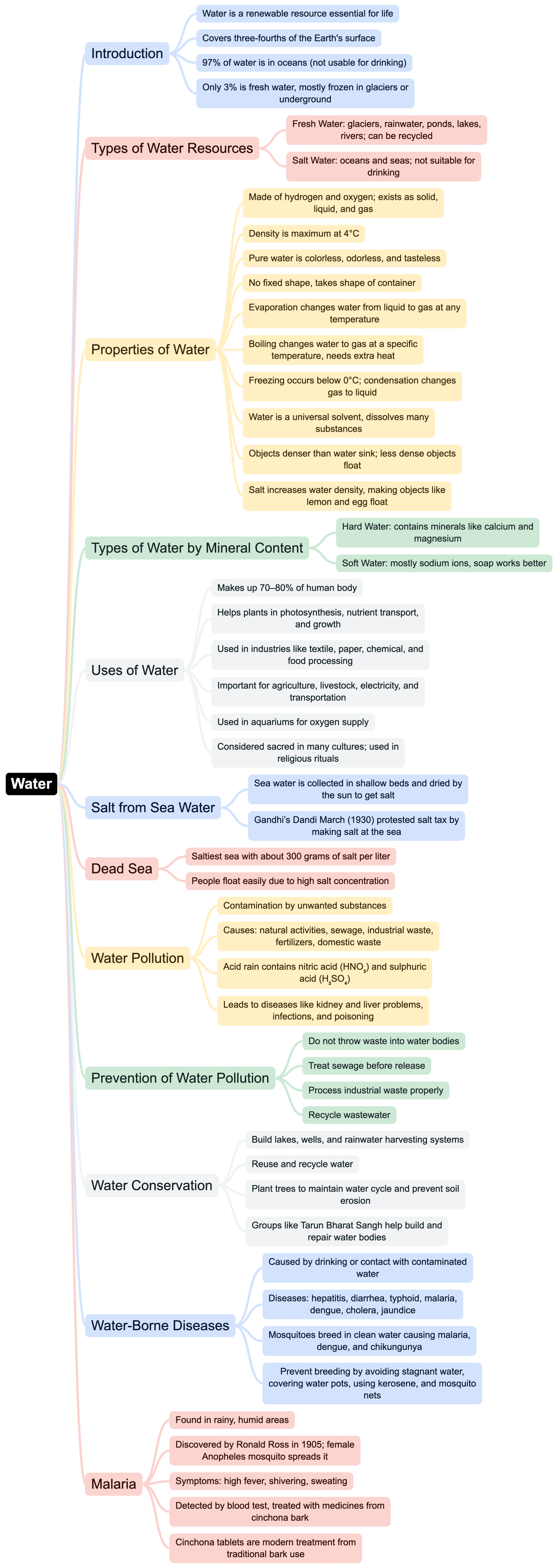CTET & State TET Exam > CTET & State TET Notes > EVS & Pedagogy Paper 1 for CTET & TET Exams > Mind Map: Water
Mind Map: Water | EVS & Pedagogy Paper 1 for CTET & TET Exams - CTET & State TET PDF Download

The document Mind Map: Water | EVS & Pedagogy Paper 1 for CTET & TET Exams - CTET & State TET is a part of the CTET & State TET Course EVS & Pedagogy Paper 1 for CTET & TET Exams.
All you need of CTET & State TET at this link: CTET & State TET
|
21 videos|140 docs|41 tests
|
FAQs on Mind Map: Water - EVS & Pedagogy Paper 1 for CTET & TET Exams - CTET & State TET
| 1. What are the different states of water ? |  |
Ans.Water exists in three primary states: solid (ice), liquid (water), and gas (water vapor). The state of water is determined by temperature and pressure. At low temperatures, water freezes to form ice, while at higher temperatures, it evaporates into vapor. When conditions change, water can transition between these states through processes such as melting, freezing, condensation, and evaporation.
| 2. Why is water essential for life on Earth ? |  |
Ans.Water is crucial for all known forms of life. It acts as a solvent, allowing chemical reactions necessary for life to occur. Water helps regulate temperature in organisms and environments, transports nutrients and waste in biological systems, and provides a habitat for various ecosystems. Without water, life as we know it would not exist, highlighting its importance in sustaining life.
| 3. How does the water cycle function ? |  |
Ans.The water cycle, also known as the hydrological cycle, describes the continuous movement of water on, above, and below the surface of the Earth. It involves processes such as evaporation (water turning into vapor), condensation (vapor cooling and forming clouds), precipitation (rain or snow falling back to Earth), and infiltration (water soaking into the ground). This cycle is vital for replenishing water sources and maintaining ecological balance.
| 4. What are the main sources of freshwater ? |  |
Ans.Freshwater sources include rivers, lakes, glaciers, and groundwater. Rivers and lakes are surface freshwater sources, while glaciers store large amounts of freshwater in frozen form. Groundwater is found beneath the Earth's surface and is accessed through wells and springs. Together, these sources provide the freshwater necessary for drinking, agriculture, and industry.
| 5. How does water pollution impact the environment ? |  |
Ans.Water pollution adversely affects ecosystems, wildlife, and human health. Contaminants such as chemicals, plastics, and pathogens can harm aquatic life, disrupt food chains, and degrade habitats. Polluted water can lead to health problems in humans, including gastrointestinal diseases and skin infections. Efforts to combat water pollution are essential for preserving biodiversity and ensuring safe water for communities.
Related Searches
















